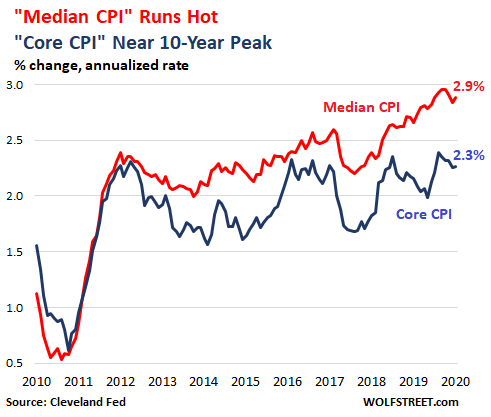Median CPI Runs Hot, Fed Averts Eyes
Despite the Fed’s proclamations, the dollar lost purchasing power at a good clip.
The inflation measure by the Cleveland Fed – the “Median CPI” – rose at 0.3% in January from December. This translates into an annualized rate of 3.7%. For the 12-month period, the Median CPI rose 2.9%. Since July last year, the index has ranged between 2.9% and 3.0%, the highest in the data series launched during the Financial Crisis.
The Median CPI is based on the data from the Consumer Price Index (CPI) but removes the extremes of price increases and price decreases, that are often temporary, to reveal underlying inflation trends. The chart shows the 12-month Median CPI, and for comparison, the “core CPI,” (CPI without the volatile food prices and the extremely volatile energy prices):

The re-collapse in oil prices pushed down inflation in gasoline and fuel oil, with the price index for motor fuels dropping -1.6% in January from December, which translates into an annual rate of -17.3%. Fuel oil and other fuels dropped at an annual rate of -15.8% in January, and used cars and trucks dropped at an annual rate of -13.5%.
At the other end of the spectrum, the price index for miscellaneous personal goods soared at an annual rate of +41% in January from December, watches and jewelry at a rate of +27.0%, footwear at a rate of +17.0%, car-and-truck rental at +15.0%.
These extremes at both ends of the spectrum, often brought about by temporary factors, skew the CPI and make it very volatile, where it jumps up and down. To obtain a measure of inflation that is not skewed by the often-temporary extremes on either end, and to show the underlying inflation trends, the Cleveland Fed’s Median CPI removes the extremes at both ends.
…click on the above link to read the rest of the article…